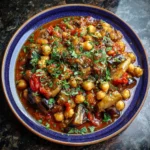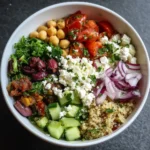Sweet and Sour Chicken with Veggies: A Flavorful Fusion of Tangy, Sweet, and Savory Delights
Sweet and Sour Chicken with Veggies is a beloved staple in American-Chinese cuisine that has captured the hearts—and taste buds—of food lovers across the globe. This vibrant dish artfully combines tender morsels of chicken with a colorful array of crisp vegetables, all enveloped in a glossy, tangy-sweet sauce that strikes the perfect balance between zesty vinegar and sugary richness. Whether served over steaming jasmine rice or enjoyed on its own, this dish offers a satisfying medley of textures and flavors that make it ideal for weeknight dinners, special gatherings, or meal prep.
The History of Sweet and Sour Chicken
The origins of sweet and sour flavor profiles trace back centuries to traditional Chinese cooking, particularly in the Guangdong (Cantonese) province. In ancient China, preserving foods with vinegar and sugar was not only practical but also led to the creation of complex flavor combinations. The original version of sweet and sour dishes often featured fish or pork, such as the classic “Gu Lao Rou” (sweet and sour pork), which used batter-fried pork tossed in a thick, vibrant sauce made from sugar, vinegar, ketchup, and sometimes pineapple juice.
As Chinese immigrants brought their culinary traditions to the United States in the 19th and early 20th centuries, they adapted their recipes to suit local tastes and ingredient availability. Thus, Sweet and Sour Chicken emerged as a popular variation. Chicken replaced pork due to its widespread appeal and lower cost, while bell peppers, onions, and pineapples were added for color, sweetness, and texture. Over time, this dish evolved into a hallmark of Chinese-American cuisine, appearing on nearly every takeout menu across North America. Despite its departure from traditional Chinese fare, it remains a cherished comfort food that bridges cultures through flavor.
Ingredients Breakdown: What Makes It Irresistible?
The magic of Sweet and Sour Chicken with Veggies lies in its harmonious blend of ingredients, each playing a vital role in creating the final masterpiece. Here’s a detailed look at the components:
- Chicken Breast or Thighs: Lean chicken breast provides a clean, protein-rich base, while thighs offer more moisture and tenderness. Both are excellent choices depending on preference.
- Bell Peppers (Red, Green, Yellow): These add crunch, color, and natural sweetness. Red peppers are the sweetest, making them ideal for balancing acidity.
- Onion (Yellow or Red): Adds depth and a subtle sharpness that mellows when cooked, enhancing the overall savory profile.
- Pineapple Chunks (Fresh or Canned): Provide natural sweetness and tartness, crucial for achieving the signature sweet-and-sour balance. Fresh pineapple adds juiciness; canned works well for convenience.
- Garlic and Ginger: Aromatics that infuse the dish with warmth and complexity, forming the flavor foundation.
- Soy Sauce: Offers umami and saltiness, balancing the sweetness of the sauce without overpowering it.
- Rice Vinegar or Apple Cider Vinegar: Delivers the essential tangy note that defines the “sour” component.
- Ketchup: Adds body, sweetness, and a hint of tomato tang—common in Americanized versions.
- Brown Sugar or Honey: Contributes rich caramel-like sweetness and helps create a glossy glaze.
- Cornstarch: Used both to coat the chicken for frying and to thicken the sauce into a velvety consistency.
- Vegetable Oil: For sautéing and frying, ensuring even cooking and crisp edges.
- Water or Chicken Broth: Forms the liquid base of the sauce, allowing flavors to meld together.
- Optional Add-ins: Carrots, broccoli, snap peas, mushrooms, or baby corn can be included to boost nutrition and texture.
Step-by-Step Recipe: How to Make Sweet and Sour Chicken with Veggies
Follow these detailed instructions to recreate an authentic-tasting, restaurant-quality Sweet and Sour Chicken with Veggies right in your kitchen.
- Prepare the Ingredients: Cut 1.5 lbs (680g) boneless, skinless chicken breasts into 1-inch cubes. Slice 1 red bell pepper, 1 green bell pepper, and 1 medium onion into thin strips. Mince 2 cloves of garlic and grate 1 tablespoon of fresh ginger. Drain one 20 oz can of pineapple chunks, reserving ½ cup of the juice.
- Marinate the Chicken: In a bowl, toss the chicken pieces with 1 tablespoon soy sauce, 1 tablespoon rice vinegar, and 1 teaspoon cornstarch. Let sit for 15–20 minutes to tenderize and absorb flavor.
- Bread the Chicken (Optional for Crispy Texture): For a crispy exterior, dip marinated chicken pieces into beaten egg, then coat with a mixture of ¼ cup cornstarch and 2 tablespoons flour. Shake off excess.
- Fry the Chicken: Heat 3–4 tablespoons vegetable oil in a large skillet or wok over medium-high heat. Add chicken in batches and cook until golden brown and fully cooked through (about 3–4 minutes per side). Remove and set aside.
- Sauté the Vegetables: In the same pan, reduce heat to medium and add 1 tablespoon oil if needed. Sauté onions for 2 minutes, then add bell peppers and stir-fry for another 3–4 minutes until slightly softened but still crisp. Add garlic and ginger; cook for 30 seconds until fragrant.
- Make the Sweet and Sour Sauce: In a mixing bowl, whisk together:
- ½ cup reserved pineapple juice
- ¼ cup ketchup
- 3 tablespoons brown sugar (or honey)
- 2 tablespoons rice vinegar
- 1 tablespoon soy sauce
- 1 teaspoon sesame oil (optional)
- 2 tablespoons water
- 1½ tablespoons cornstarch
- Combine and Simmer: Pour the sauce mixture into the pan with the vegetables. Stir constantly and bring to a gentle boil. Cook for 1–2 minutes until the sauce thickens and turns glossy.
- Add Chicken and Pineapple: Return the cooked chicken to the pan. Add the drained pineapple chunks. Gently toss everything together, coating evenly with the sauce. Simmer for 2–3 minutes to allow flavors to meld.
- Taste and Adjust: Sample the dish and adjust seasoning if needed—add more sugar for sweetness, vinegar for tang, or soy sauce for saltiness.
- Serve Hot: Transfer to a serving platter or individual bowls. Garnish with sliced green onions or toasted sesame seeds if desired. Serve immediately over cooked white rice, brown rice, or cauliflower rice for a low-carb option.
Pro Tips for the Best Sweet and Sour Chicken
- Don’t Overcook the Chicken: To keep it juicy, avoid overcrowding the pan when frying. Cook in batches and remove once golden and just cooked through.
- Control Sauce Thickness: If the sauce is too thick, add a splash of water or broth. If too thin, mix 1 tsp cornstarch with 1 tbsp cold water and stir into the simmering sauce.
- Use Fresh Pineapple Wisely: Fresh pineapple contains bromelain, an enzyme that can make meat mushy if marinated too long. Stick to short marination times or use canned pineapple for consistent results.
- Double the Sauce (for Meal Prep): The sauce keeps well and enhances leftovers. Consider making extra to freeze for future use.
- High Heat for Wok Flavor: If using a wok, preheat it until smoking before adding oil—a technique called “wok hei” that imparts a distinctive roasted aroma.
- Prep Ahead: Chop all ingredients in advance. This stir-fry comes together quickly, so having everything ready ensures smooth execution.
Variations and Customizations
Sweet and Sour Chicken is incredibly versatile and can be tailored to fit dietary needs, flavor preferences, or seasonal ingredients.
- Vegetarian/Vegan Version: Replace chicken with tofu, tempeh, or seitan. Use maple syrup instead of honey and ensure the soy sauce is gluten-free if needed.
- Gluten-Free Option: Use tamari or a certified gluten-free soy sauce. Ensure cornstarch and other ingredients are labeled gluten-free.
- Low-Sugar Version: Substitute brown sugar with monk fruit sweetener or erythritol. Reduce ketchup amount or use a sugar-free alternative.
- Spicy Kick: Add red pepper flakes, sriracha, or diced jalapeños to the sauce for heat. A few dashes of chili garlic sauce also work well.
- Different Proteins: Try shrimp, pork, or turkey cutlets for alternate takes on the dish.
- Extra Veggies: Incorporate broccoli florets, sliced carrots, zucchini, snow peas, or mushrooms for added nutrients and color variety.
- Baked Instead of Fried: For a healthier twist, skip frying and bake the chicken at 400°F (200°C) for 18–20 minutes after coating with cornstarch. Toss with sauce afterward.
- Pineapple-Free: Omit pineapple and increase bell peppers or add mango or orange segments for similar sweetness.
Health Considerations and Nutritional Value
Sweet and Sour Chicken with Veggies can be part of a balanced diet when prepared thoughtfully. While traditional versions may be high in sugar and sodium, simple modifications can enhance its nutritional profile.
Nutritional Highlights (per serving, approx. 1.5 cups with rice):
- Calories: ~400–500 kcal (varies based on preparation)
- Protein: 25–30g (from chicken and vegetables)
- Carbohydrates: 50–60g (mainly from sugar, cornstarch, and rice)
- Fat: 10–15g (mostly unsaturated from healthy oils)
- Fiber: 3–5g (from bell peppers, onions, and optional added veggies)
- Vitamins & Minerals: Rich in Vitamin C (from peppers and pineapple), Vitamin A, potassium, and antioxidants.
Health Tips:
- Reduce Sugar: Limit added sugars by cutting down on brown sugar and ketchup. Use natural fruit sweetness where possible.
- Lower Sodium: Opt for low-sodium soy sauce and limit added salt. Rinse canned pineapple to reduce sugar content.
- Healthy Fats: Use heart-healthy oils like avocado or grapeseed oil instead of palm or hydrogenated oils.
- Balanced Meal: Pair with brown rice or quinoa for fiber, and include a side salad to boost micronutrient intake.
- Portion Control: Serve moderate portions with plenty of vegetables to manage calorie density.
Full Ingredient List
- 1.5 lbs (680g) boneless, skinless chicken breasts or thighs, cubed
- 1 red bell pepper, sliced
- 1 green bell pepper, sliced
- 1 medium yellow onion, sliced
- 1 (20 oz) can pineapple chunks in juice, drained (reserve ½ cup juice)
- 2 cloves garlic, minced
- 1 tbsp fresh ginger, grated
- 3–4 tbsp vegetable oil (for frying and sautéing)
- 1 egg (optional, for breading)
- ¼ cup cornstarch (plus extra for sauce)
- 2 tbsp all-purpose flour (optional, for crispiness)
- 1 tbsp soy sauce (low-sodium preferred)
- 1 tbsp rice vinegar (or apple cider vinegar)
- ½ cup pineapple juice (reserved from can)
- ¼ cup ketchup (preferably no sugar added)
- 3 tbsp brown sugar or honey (adjust to taste)
- 2 tbsp rice vinegar
- 1 tbsp soy sauce
- 1 tsp sesame oil (optional)
- 2 tbsp water
- 1½ tbsp cornstarch (for sauce thickening)
- Salt and pepper to taste
- Garnish: sliced green onions, sesame seeds
Detailed Directions Recap
- Marinate chicken in soy sauce, vinegar, and 1 tsp cornstarch for 15–20 minutes.
- (Optional) Dip chicken in egg, then coat with cornstarch-flour mix.
- Fry chicken in hot oil until golden and cooked through. Set aside.
- In same pan, sauté onions, then add bell peppers, garlic, and ginger.
- Whisk sauce ingredients (pineapple juice, ketchup, sugar, vinegar, soy sauce, sesame oil, water, and 1.5 tbsp cornstarch).
- Pour sauce into pan and bring to a boil, stirring until thickened.
- Add chicken, pineapple, and any accumulated juices. Stir gently to coat.
- Simmer 2–3 minutes. Adjust seasoning.
- Serve hot over rice, garnished with green onions or sesame seeds.
Frequently Asked Questions (FAQ)
Q: Can I make Sweet and Sour Chicken without frying?
A: Absolutely! You can bake the chicken at 400°F (200°C) for 18–20 minutes on a greased baking sheet, or air-fry at 375°F for 12–15 minutes. Toss with sauce after cooking.
Q: Is this recipe freezer-friendly?
A: Yes! Freeze the cooked dish (without rice) in airtight containers for up to 3 months. Reheat on the stove or microwave, adding a splash of water to refresh the sauce.
Q: Why is my sauce too thin or too thick?
A: Too thin? Mix 1 tsp cornstarch with 1 tbsp cold water and stir into simmering sauce. Too thick? Add small amounts of water or broth until desired consistency.
Q: Can I use frozen vegetables?
A: Yes, but thaw and pat dry first to prevent excess moisture. Stir-fry briefly just to heat through.
Q: What kind of rice pairs best?
A: Jasmine rice is traditional and aromatic. Brown rice adds fiber, while cauliflower rice makes it keto-friendly.
Q: Can I prepare this ahead of time?
A: Yes! Chop all ingredients and store separately. Cook the dish fresh for best texture, but you can pre-mix the sauce and refrigerate for up to 3 days.
Q: Is Sweet and Sour Chicken healthy?
A: It can be! By reducing sugar, using lean protein, increasing vegetables, and choosing healthy cooking methods, you can enjoy a nutritious version packed with flavor.
Summary
Sweet and Sour Chicken with Veggies is a vibrant, crowd-pleasing dish that blends tender chicken, crisp vegetables, and a lusciously balanced sauce bursting with tangy sweetness. Easy to customize and perfect for family dinners or meal prep, it brings restaurant-quality flavor straight to your home kitchen.










